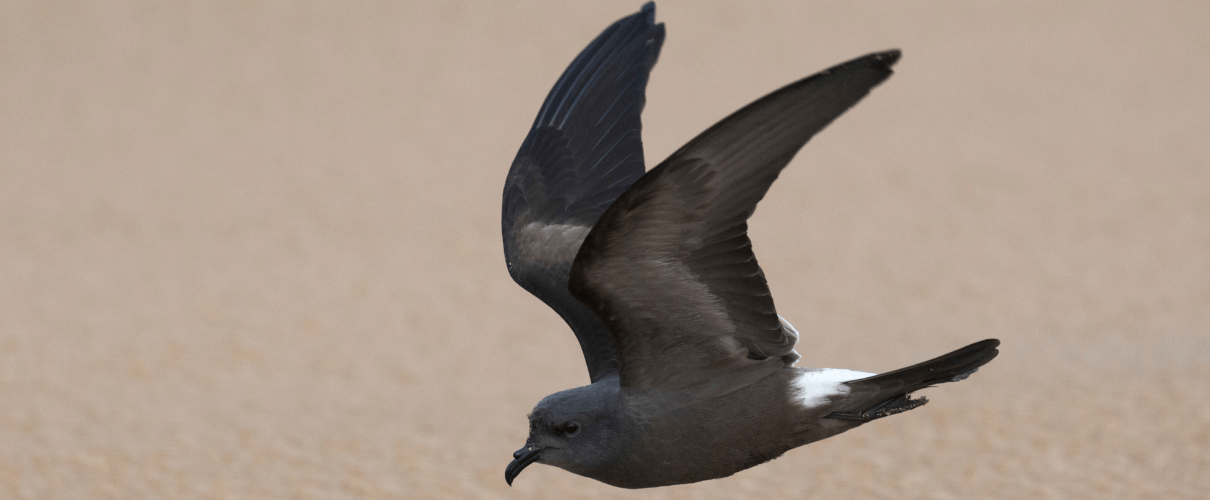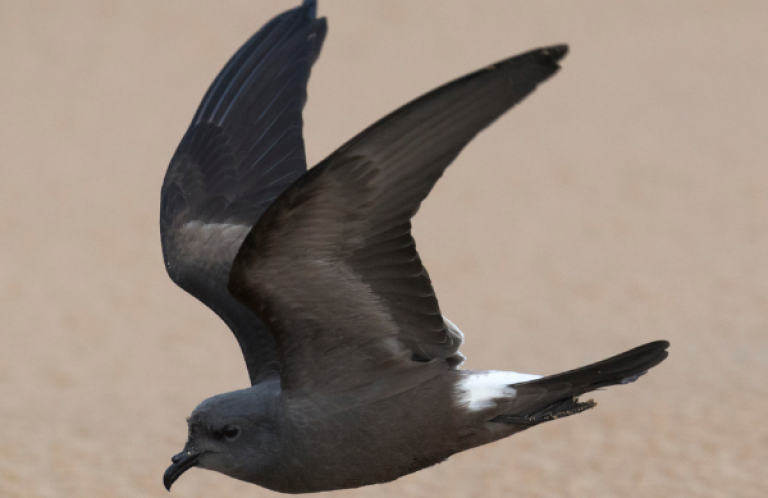New Study Shows Eradicating Invasive Species from Islands Produces Global Impact

Leach's Storm-Petrel by Agami Photo Agency/Shutterstock
(August 10, 2022) Islands are a globally significant opportunity for biodiversity conservation. A new study published on August 10 in Scientific Reports shows that invasive species elimination from islands has been implemented widely around the world with a high success rate. This baseline conservation action is key for protecting native plants and animals, creating ecosystem resilience to climate change, and providing co-benefits to people.
“There are few conservation interventions that provide such rapid and lasting conservation returns as removing invasive species from islands,” said Brad Keitt, Director of American Bird Conservancy's (ABC) Oceans and Islands Programs. “I have witnessed reproductive success of Scripps's Murrelet go from near zero to more than 75 percent in one year, and previously undocumented species like Cassin's Auklets or Leach's Storm-Petrels begin to breed the year after invasives are removed.”
The study, “The global contribution of invasive vertebrate eradication as a key island restoration tool,” is the first synthesis of all reported eradication events of invasive vertebrates on islands worldwide. It includes more than 100 years of 1,550 invasive vertebrate eradication attempts from 998 islands using the Database of Island Invasive Species Eradications (DIISE), a publicly available dataset tracking island eradications. Invasive species are a key threat to island ecosystems, and the analysis found an 88 percent success rate and significant growth in the number of eradications since the 1980s.
“Our study found that success rates from invasive species eradications are high and have remained stable over time,” said Dena Spatz, lead author of the paper and senior conservation scientist at Pacific Rim Conservation. “This is a testament to the hard work of people and partnerships seeking to prevent species extinctions and restore island ecosystems.”
Islands are global hotspots for biodiversity and extinction, representing only about 5 percent of Earth's land area but enduring 61 percent of extinctions since the 1500s and hosting 40 percent of today's highly threatened vertebrates. Invasive species, especially mammals like rats, cats, and goats, were introduced to islands by humans either deliberately or accidentally, causing harmful outcomes such as extinctions by eating native species and damaging habitat. Completely removing invasive species from islands has proven to be one of the most effective tools at halting and reversing this damage.
“There is an amazing global impact by summing these local conservation interventions,” said Nick Holmes, co-author on the paper from The Nature Conservancy. “This synthesis shows the remarkable conservation gains that have been collectively made on islands and builds on past work showing the tangible benefit to biodiversity.”
The team's analysis found that eight countries were responsible for 80 percent of all documented eradications: New Zealand, Australia, France, the United Kingdom, the United States, Mexico, Seychelles, and Ecuador. Many of these countries have successfully completed multiple smaller projects, particularly targeting rats on small islands, and are now focusing on larger eradication projects and a variety of species.
In 2011, invasive rats were removed from Palmyra Atoll, Line Islands, U.S. The atoll continues to recover dramatically — germination of native plant seedlings increased by more than 5,000 percent, two previously undocumented crab species became abundant, and current studies show coral recovering lost territory in the atoll's lagoons.
“Palmyra Atoll is thriving in the absence of invasive rats — both on land and under the water,” said Alex Wegmann, a lead scientist at The Nature Conservancy.
In the Seychelles, successful eradication has occurred on more than 20 islands, improving biodiversity and providing a foundation for achieving additional conservation results.
“Countries that have been restoring islands for decades were able to because of their investments in innovations and resources,” said David Will, co-author and head of innovation at Island Conservation. “They are now looking to larger, more challenging projects such as those with substantial human communities and adding on restoration work like species translocation, which is made possible once the threat of invasive species is removed. This trend reflects the need for investment in methods and approaches that increase efficiency and overcome the current social, ethical, and financial constraints of available tools.”
The study also demonstrated that more countries are implementing eradications today than ever before to realize the associated benefits to biodiversity and human well-being. The practice is especially powerful in coastal countries and island nations, like the Small Island Developing States, where globally threatened biodiversity and human communities often coexist and the impacts of invasive species are exacerbated.
While eradicating invasive species from islands has had enormous biodiversity and ecosystem benefits, invasive species have only been eradicated from fewer than 20 percent of islands with globally threatened species, signifying more action is urgently needed.
“Despite the global application of invasive species eradications, the current pace of conservation action is still insufficient to meet global biodiversity targets and reverse current extinction trajectories,” said Piero Genovesi, co-author on the paper and chair of the IUCN SSC Invasive Species Specialist Group. “It is clear that a greater investment in invasive species eradications would make reliable gains towards restoring global biodiversity and benefiting humans. We need the support of national and international agreements and institutions alongside community empowerment and participation in invasive species eradication to achieve global environmental goals.”
Authors of the Scientific Reports paper include: Dena R. Spatz of Pacific Rim Conservation; Nick D. Holmes of The Nature Conservancy; David Will and Stella Hein of Island Conservation; Stella Hein, Donald A. Croll, and Bernie Tershy of University of California–Santa Cruz; Zachary T. Carter, Rachel M. Fewster, and James C. Russell of University of Auckland, New Zealand; Brad Keitt of American Bird Conservancy, Piero Genovesi of the Institute for Environmental Protection and Research (ISPRA) and IUCN SSC Invasive Species Specialist Group, Italy; and Araceli Samaniego of Landcare Research, New Zealand.
Case Studies:
San Benito Oeste Island, Mexico
In Mexico's San Benito Archipelago, a team of locals, conservation specialists from the Grupo de Ecología y Conservación de Islas, and the Mexican government eradicated a suite of invasive mammals off San Benito Oeste Island, the only inhabited island in the archipelago, to protect this internationally important region and conserve 13 seabird species, including Cassin's Auklets and Black-vented Shearwaters. In 2000, the island was declared invasive mammal-free. In 2006, the local community detected an unusual new invader, the Cactus Mouse, which came from nearby Cedros Island. It was finally eradicated in 2013. Since then, there have been biosecurity measures set in place to keep the island's mammal-free status.
Cabritos Island, Dominican Republic
In 2013, two globally threatened iguana species were protected on Cabritos Island through local and international partnerships that removed a suite of invasive species, including feral cats and donkeys that were eating young iguanas and damaging island habitat.
“Because of our intervention on Cabritos Island, the Endangered Ricord's Iguana and the Endangered Rhinoceros Iguana are recovering,” said Jorge Brocca, Executive Director of SOH Conservación.
Antipodes Island, New Zealand
In 2016, a global partnership came together to remove invasive mice from Antipodes Island to help protect the island's endemic and native species from extinction, such as the Antipodean and Reischek's Parakeets.
“The success on Antipodes Island motivated New Zealand to pursue more ambitious eradication programs currently under development, such as on the larger and inhabited Stewart Island, continuing to pave the way for key invasive mammals to be removed from the entirety of New Zealand by 2050,” said James Russell of The University of Auckland.
About the DIISE Database
The Database of Islands and Invasive Species Eradications (DIISE) collates the implementation of invasive vertebrate species eradication efforts on islands worldwide. All DIISE data are publicly available in both Spanish and English at http://diise.islandconservation.org.
###
American Bird Conservancy is a nonprofit organization dedicated to conserving wild birds and their habitats throughout the Americas. With an emphasis on achieving results and working in partnership, we take on the greatest problems facing birds today, innovating and building on rapid advancements in science to halt extinctions, protect habitats, eliminate threats, and build capacity for bird conservation. Find us on abcbirds.org, Facebook, Instagram, and Twitter (@ABCbirds).
Media Contact: Jordan Rutter, Director of Public Relations| jerutter@abcbirds.org | @JERutter


















































